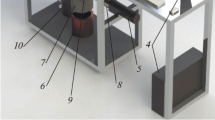Abstract
Studies have been made on the fragmentation of liquid metal drops falling through a waterglycerine mixture containing small amounts of nitrogen bubbles owing to the passage of a strong shock wave. The apparent drop volume increased with lime, but neither stripping of small droplets nor misty wake formation was observed in the high-speed photographs. The drop flattened initially into a spherical cap which increased in radius, but remained smooth, within the time period of interest. Hence the Taylor instability is not the principal fragmentation mechanism at these Weber numbers (5-644). Entrainment of liquid into the drop was the cause of breakup, and was postulated to be due to turbulent mixing resulting from vorticity generation near the plane of separation. A hydrodynamic fragmentation model was developed which predicts the rale of drop volume increase reasonably well. The breakup time constant was presented, and drop trajectory can also be predicted from the model.
Similar content being viewed by others
References
Bankoff, S.G.: Proc. 6th Int. Heat Transfer Conf., Toronto, Canada,6, 355 (1978).
Fauske, H.K.:Nucl. Sci. Eng.,51, 95 (1973).
Board, S.J., Hall, R.W. and Hall, R.S.:Nature,254,319(1975).
Ranger, A.A. and Nicholls, J.A.:A1AA 1,7, 285 (1969).
Harper, E.Y., Grube, G.W. and Chang, l.-Dee:J. Fluid Mech.,52, 565 (1972).
Simpkins, P.G. and Bales, E.L.:J. Fluid Mech.,55, 629 (1972).
Reinecke, W.R. and Waldman, G.: 3rd Int. Conf. on Rain Erosion and Related Phenomena, Hamp- shire, England (1970).
Patel, P.D. and Theofanous, T.G.:J. Fluid Mech.,103,307(1981).
Baines, M. and Buttery, N.E.: CEGB Report RD/ B/N/4643 (1979).
Kim, D.S., Burger, M., Fröhlich, G. and Unger, H.: Int. Mtg. on LWR Severe Accident Evaluation, ANS/ENS, Boston, MA (1983).
Wolfe, H.E. and Anderson, W.H.: AGCD Report No. 0395-04 (1964).
Engel, O.G.:J. Research of the National Bureau of Standards,60, No. 3 (1958).
Wang, C.P.:Phys. Fluids,16, 744 (1973).
Scorer, R.S.:J. Fluid Mech.,2, 583 (1957).
Taylor, G.I.:Proceeding Royal Society, London,201, 159(1950).
Author information
Authors and Affiliations
Rights and permissions
About this article
Cite this article
Yang, JW., Yang, HS. Liquid-liquid mixing for the breakup of accelerating drops. Korean J. Chem. Eng. 7, 22–30 (1990). https://doi.org/10.1007/BF02697338
Received:
Accepted:
Issue Date:
DOI: https://doi.org/10.1007/BF02697338




